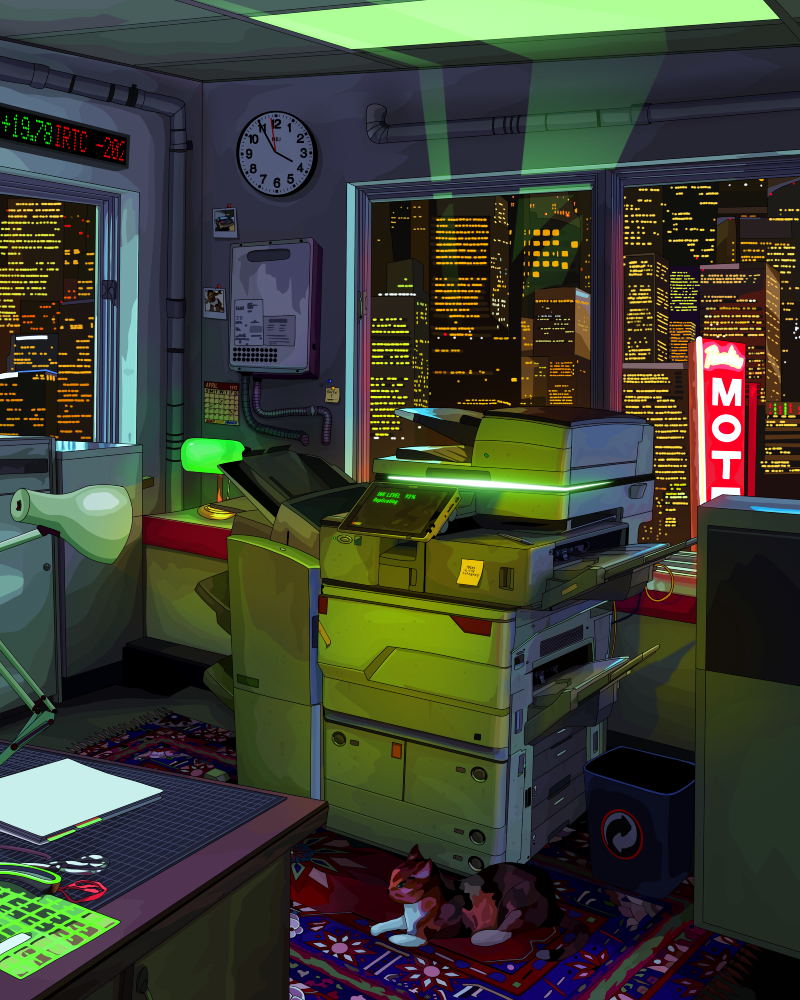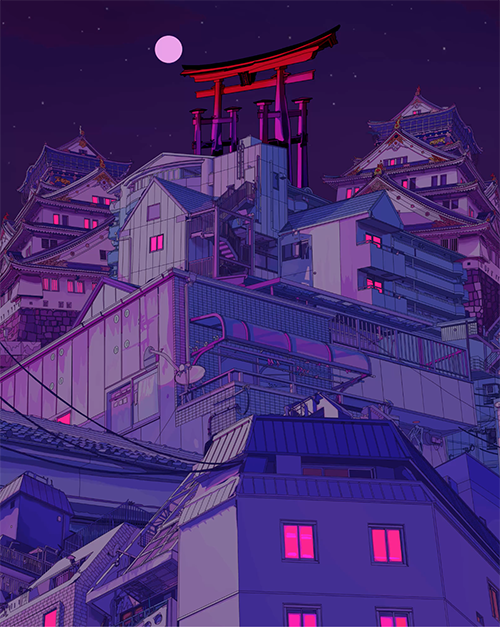Please note that the following review is not an endorsement of purchasing the NFTs discussed, and the author does not themself own any of the collection.
NFTs come in a broad range of formats, from video clips to still images to audio clips. The most intriguing examples, however, are the ones that make use of the unique functionality of NFTs themselves. A good example is the REPLICATOR collection by Canadian NFT artist Mad Dog Jones (also known as Michah Dowbak) which takes full advantage of the power of smart contracts to offer some intriguing possibilities.
Originating with a short animated video clip of a photocopier, each entry in the collocation retains that central element but varies the surrounding environment. So far, so expected for NFT art. But tying in with the theme of replication, the smart contract contained within NFTs in the collection creates new NFT generations over time.
The project has seven distinct generations containing bespoke artwork, all with cyberpunk, dystopian stylings that neatly align with Web3 concepts such as the metaverse. The original piece was sold by art dealer Phillips for $4,144,000 In April 2021 and according to the artist’s site, so far 208 examples have been generated.
To avoid exponential growth where each piece could generate new versions indefinitely, Dowbak’s collection is capable of producing so-called jams (again referencing the photocopier central to the pieces) which result in unique artworks but also stop a generation from being able to replicate any further.

The Collection
The animation in each piece tends to be relatively low-key, dedicated to producing an overall mood rather than drawing too much attention. Sometimes that can work against the piece’s favour, but it does ensure that the mood tends to be both intimate, thanks to the cramped confines and soft lighting, and unsettling, with an everpresent dystopian skyline outside.
The selection of a photocopier as the main subject of the collection is a pointed one, with Phillips noting that it’s a “nostalgic nod to a once-cutting-edge technology, now on its way toward obsolescence.” With that in mind, the collection reflects on the current ubiquity of NFTs – serving as a memento mori that nothing last forever.
Of course, it also ties in thematically with the concept of replication, as well as contributing to a 1980s aesthetic. “REPLICATOR is the story of a machine through time. It is a reflection on forms of past groundbreaking innovation and serves as a metaphor for modern technology’s continuum. I’m interested to see how collectors will respond as the work evolves and the NFTs in their possession continue to create new generations,” said Mad Dog Jones.
What this means is that the collection can include a narrative that reveals itself over time. In the original generation, we see a copy machine turning on and off in an office setting. In some of the collection, the looming threat of the outside has successfully crept in, as with a Generation 6 example in which the copier and the room at large have been destroyed and sprayed with graffiti. Most are much lower key, however, whether that’s a waste paper basket fire in Generation 3 or a lizard invasion in Generation 4.
The Background
This is not Mad Dog Jones first foray into NFTs, having previously worked on a collection known as Crash + Burn, which consisted of seven unique pieces. Accessing said pieces required ownership of five separate examples from a previous NFT drop. Once collected, they could be sent to the artist, who would burn them in exchange for an item from the Crash + Burn collection. In doing so, Mad Dog Jones rewarded owners of pieces from his first collection, which saw an increase in value thanks to the sudden addition of new utility.

The deployment of random chance means the collection also engages with the broader world of “aleatoric” or “aleatory” art whereby artists have embraced the role of random chance in their artworks. Randomisation is a prominent feature of the NFT landscape, as with the interchangeable traits that constitute the characters of the best-known NFT collections such as the Bored Ape Yacht Club.
It raises an interesting broader point about the artistic value of algorithmically-assembled pieces. While individual elements may have had plenty of thought put into them, their combination could produce an undesirable effect. That possibility has become an accepted part of the NFT market, with the masses of unremarkable and ugly examples inflating the price of the ones that are thematically coherent (although exceptionally ugly examples can become more valuable by virtue of that fact).
The Verdict
REPLICATOR is a good example of the possibilities afforded to artists who embrace the unique possibilities of Web3. Thanks to the power of smart contracts, pieces that would otherwise be experienced as fairly disposable art objects can be given utility that radically extends their lifespans.




- 000
- 2021
- a
- About
- accessing
- According
- addition
- ADvantage
- against
- All
- Although
- April
- Art
- artist
- artistic
- Artists
- artwork
- artworks
- attention
- audio
- become
- being
- Canadian
- capable
- central
- characters
- clips
- collection
- collections
- collectors
- combination
- come
- concept
- constitute
- continue
- Continuum
- contract
- contracts
- contributing
- could
- Crash
- create
- creates
- credit
- Current
- dedicated
- deployment
- destroyed
- drawing
- Drop
- each
- effect
- elements
- embrace
- Environment
- example
- examples
- exchange
- expected
- experienced
- Feature
- First
- following
- forever
- forms
- from
- full
- functionality
- further
- generate
- generation
- generations
- good
- groundbreaking
- Growth
- having
- How
- However
- HTTPS
- images
- include
- Increase
- individual
- Innovation
- interested
- IT
- itself
- Key
- known
- landscape
- large
- machine
- make
- Market
- means
- Metaverse
- mind
- more
- most
- NFT
- NFTs
- offer
- Office
- original
- otherwise
- overall
- own
- owners
- ownership
- Paper
- part
- piece
- pieces
- Plenty
- Point
- possession
- possibilities
- possibility
- power
- previous
- price
- produce
- project
- prominent
- purchasing
- raises
- range
- reflection
- reflects
- required
- Reveals
- review
- rewarded
- Role
- Said
- selection
- serving
- setting
- Short
- site
- smart
- smart contract
- Smart Contracts
- So
- Soft
- sold
- some
- Spotlight
- Still
- Story
- subject
- Successfully
- sudden
- Technology
- The
- theme
- Through
- time
- unique
- use
- utility
- value
- Video
- Web3
- whether
- while
- WHO
- within
- Work
- worked
- world
- would













